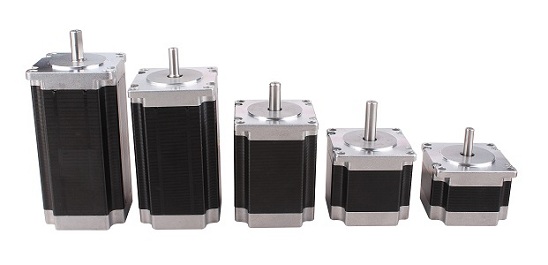Stepper Motors
These motors are also called stepping motors or step motors. The name stepper is used because this motor rotates through a fixed angular step in response to each input current pulse received by its controller. In recent years, there has been widespread demand of stepping motors because of the explosive growth of the computer industry. Their popularity is due to the fact that they can be controlled directly by computers, microprocessors and programmable controllers. As we know, industrial motors are used to convert electric energy into mechanical energy but they cannot be used for precision positioning of an object or precision control of speed without using closed-loop feedback. Stepping motors are ideally suited for situations where either precise positioning or precise speed control or both are required in automation systems. Apart from stepping motors, other devices used for the above purposes are synchros and resolvers as well as dc/ac servomotors The unique feature of a stepper motor is that its output shaft rotates in a series of discrete angular intervals or steps, one step being taken each time a command pulse is received. When a definite number of pulses are supplied, the shaft turns through a definite known angle. This fact makes the motor well-suited for open-loop position control because no feedback need be taken from the output shaft. Such motors develop torques ranging from 1 μN-m (in a tiny wrist watch motor of 3 mm diameter) upto 40 N-m in a motor of 15 cm diameter suitable for machine tool applications. Their power output ranges from about 1 W to a maximum of 2500 W. The only moving part in a stepping motor is its rotor which has no windings, commutator or brushes. This feature makes the motor quite robust and reliable.
Step Angle
The angle through which the motor shaft rotates for each command pulse is called the step angle β. Smaller the step angle, greater the number of steps per revolution and higher the resolution or accuracy of positioning obtained. The step angles can be as small as 0.72º or as large as 90º. But the most common step sizes are 1.8º, 2.5º, 7.5º and 15º. The value of step angle can be expressed either in terms of the rotor and stator poles (teeth) Nr and Ns respectively or in terms of the number of stator phases (m) and the number of rotor teeth.
Resolution is given by the number of steps needed to complete one revolution of the rotor shaft. Higher the resolution, greater the accuracy of positioning of objects by the motor
∴ Resolution = No. of steps / revolution = 360º / β
A stepping motor has the extraordinary ability to operate at very high stepping rates (upto 20,000 steps per second in some motors) and yet to remain fully in synchronism with the command pulses.
When the pulse rate is high, the shaft rotation seems continuous. Operation at high speeds is called ‘slewing’. When in the slewing range, the motor generally emits an audible whine having a fundamental frequency equal to the stepping rate. If f is the stepping frequency (or pulse rate) in pulses per second (pps) and β is the step angle, then motor shaft speed is given by,
If the stepping rate is increased too quickly, the motor loses synchronism and stops. Same thing happens if when the motor is slewing, command pulses are suddenly stopped instead of being progressively slowed.
Stepping motors are designed to operate for long periods with the rotor held in a fixed position and with rated current flowing in the stator windings. It means that stalling is no problem for such motors whereas for most of the other motors, stalling results in the collapse of back emf (Eb) and a very high current which can lead to a quick burn-out.
Applications :
Such motors are used for operation control in computer peripherals, textile industry, IC fabrications and robotics etc. Applications requiring incremental motion are typewriters, line printers, tape drives, floppy disk drives, numerically-controlled machine tools, process control systems and X-Y plotters. Usually, position information can be obtained simply by keeping count of the pulses sent to the motor thereby eliminating the need for expensive position sensors and feedback controls. Stepper motors also perform countless tasks outside the computer industry. It includes commercial, military and medical applications where these motors perform such functions as mixing, cutting, striking, metering, blending and purging. They also take part in the manufacture of packed food stuffs, commercial endproducts and even the production of science fiction movies.











 Hybrid Stepper Motor
Hybrid Stepper Motor



